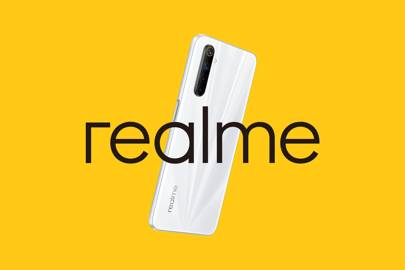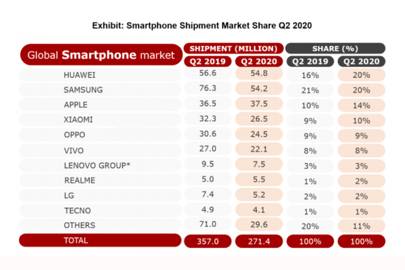
As Samsung falls behind Huawei, placing second for global smartphone shipments in the second quarter of 2020, only two top-ten manufacturers actually increased sales or market share in the same quarter. One of these youve likely never heard of.
The first, placing at number three, is Apple. With the launch of the iPhone SE, the company is beating Android flagship-makers at their own game. As for the other brand on the up, meet Apples unlikeliest rival; Realme.
Who? Unless youre a smartphone forum fan after a bargain, or subscribe to mobile tech YouTubers, theres a good chance the waves Realmes been making havent rocked your boat yet. The latest Counterpoint report, however, suggests its time to pay attention.
Realme is a Chinese smartphone manufacturer thats only a little over two years old. Its part of BBK Electronics Corporation, which has a complicated history spawning brands like iQOO, and the better known OnePlus, Oppo and Vivo. Realme was created in a similar way to OnePlus, built as a separate brand from BBK and Oppo, but given access to Oppos IP, economies of scale for buying components, as well as its extensive factory lines. While OnePlus doesnt featured in the top ten list of second-quarter shipments at all, and Oppo has taken a hit in terms of devices shipped, Realme appears to have flourished. But why?
Realme’s founder, Sky Li, is an ex-Oppo protege. Li masterminded Oppos international expansion, and with a proven track record has kept Realmes business uncompromisingly singular in message: excellent value. Since launching, its portfolio has swollen into a budget banquet of premium features at competition-beating prices perfect for brand-agnostic, Covid-era buyers.

But Realme didnt launch in its native China. The brand was originally designed to disrupt the highly prized Indian smartphone market, which has over one billion adults. Smartphones and phones, in general, have played a huge part in Indian culture for decades. Their importance as status symbols is likely on an equal footing with their utility as communication tools. Naturally, not everyone, and, more specifically, not everyone in India can afford a £1,000 smartphone, so while many Indian buyers may aspire to own iPhones, many land on brands like Realme.
Realme has done well, growing in a relatively small base in key markets such as India, South East Asia and, more recently, with an expansion in Europe, says Neil Shah, an analyst at Counterpoint. Its low-cost and aggressive pricing, as well as its e-commerce-based go-to-market strategy has helped Realme drive growth in these markets in particular.
That strategy has its downsides. By selling direct through retailers such as Amazon, Realme is able to cut costs. Ben Woods, chief of research at CCS Insights, points out that the firm doesn’t get its devices certified by the GCF which means it cant be sold by most mobile network operators.
The rise of Realme can also, in part, be attributed to the change in Indias smartphone usage habits, too. Many Indians dont have fixed broadband. To put into context how big a deal mobile data is, the average smartphone user in India churned through 12GB of data per month in 2019 according to telecoms company, Ericsson thats the highest consumption per head in the world. This likely explains why the countrys networks are upgrading from GPRS to 4G data speeds in many areas, totally leapfrogging 3G.
Combine improved connectivity, increased data needs and usage, and affordable 4G phones entering the market from the likes of Realme, and youve got the perfect conditions for a value brand to thrive.
After success in India, Realme has started to make moves into Europe. The first Realme phone to launch on the continent was the 199 Realme 3 Pro. Next, the Realme X2 Pro was a headline-grabber the worlds first phone with a 64MP camera plus flagship power at 399. Since then, Realme has produced quad-cameras, superzooms, 5G phones, high refresh rate HDR OLED screens and more. But one thing it hasnt done is charge big bucks.
At the time of writing, Realme has no less than six 2020 smartphones on sale in the UK, starting at £189 for the Realme 6i, through to the £299 Realme X50 5G a cheaper OnePlus Nord-a-like, all the way to Realmes flagship, the £569 Realme X50 Pro 5G, a lower cost, better-specced alternative to the OnePlus 8.
Remember that OnePlus, which launched in 2013 in China, started life with the moniker flagship killer, and the slogan Never Settle. From flagship killer, to flagship maker, however, the companys strategy has become muddled, with the OnePlus 8 and 8 Pro being the most expensive in the line, with the Pro starting at £799, and climbing to £899. Both are cheaper than most other flagships, but they arent affordable by any stretch of the imagination. So while OnePlus has worked on building a premium brand, Realme has quietly crept into the lower-end of the market.
Realme isn’t just undercutting the competition with phones. Its affordable everything business plan includes a pair of wireless in-ear buds that cost £29.99 and theyre not terrible. Meanwhile, the Realme Watch is £49.99; the brands AirPod alternatives the Realme Air Neos cost £39.99, and theres a £34.99 fitness tracker, taking on Xiaomis budget Mi Band-series head-on.
As the UK nosedives into its first recession in 11 years and the world is in economic turmoil, impressively, Realme has flourished. Of course, the smartphone industry isnt short of cautionary tales. Will Realme become the new darling brand for budget buyers happy with pay-as-you-go SIM cards? It has a long way to go but dont expect it to remain an obscure player for long.
More great stories from WIRED
🚚 The French town that created its own Amazon
🦆 Google got rich from your data. DuckDuckGo is fighting back
😷 Which face mask should you buy? The WIRED guide
🔊 Listen to The WIRED Podcast, the week in science, technology and culture, delivered every Friday
